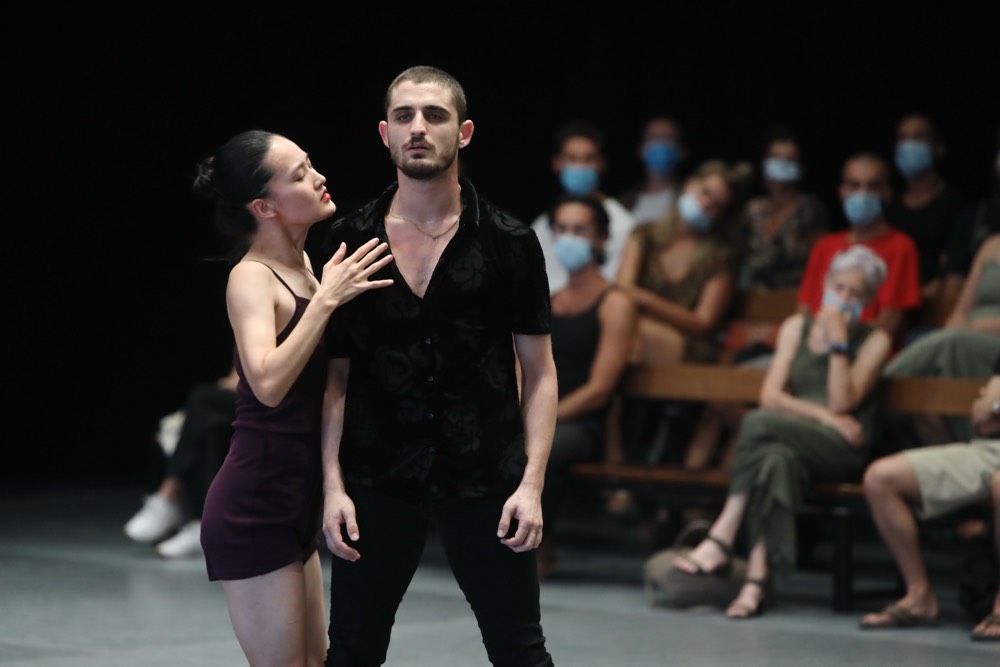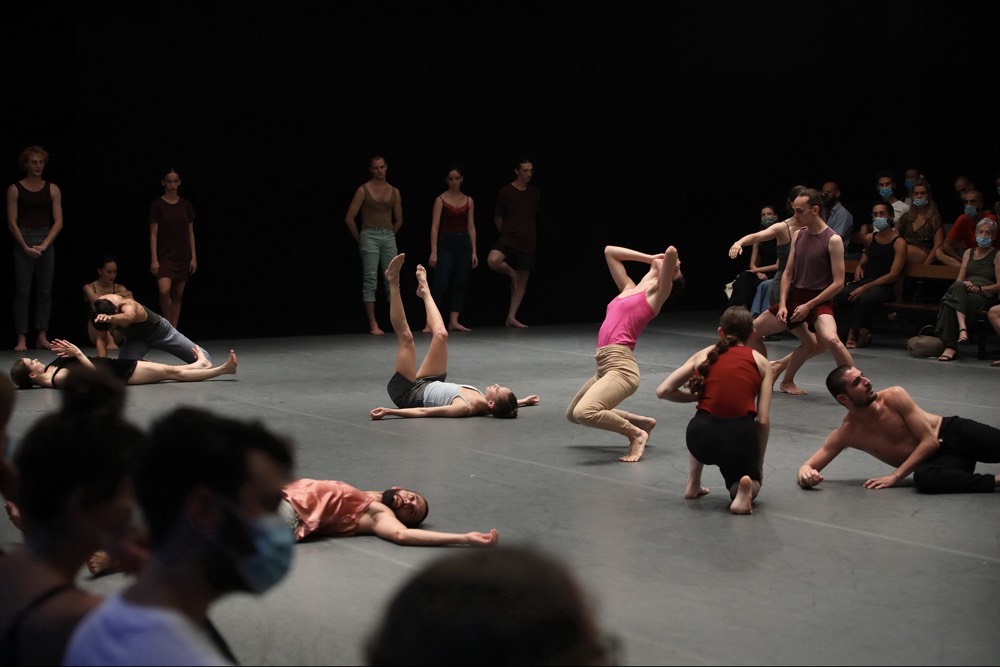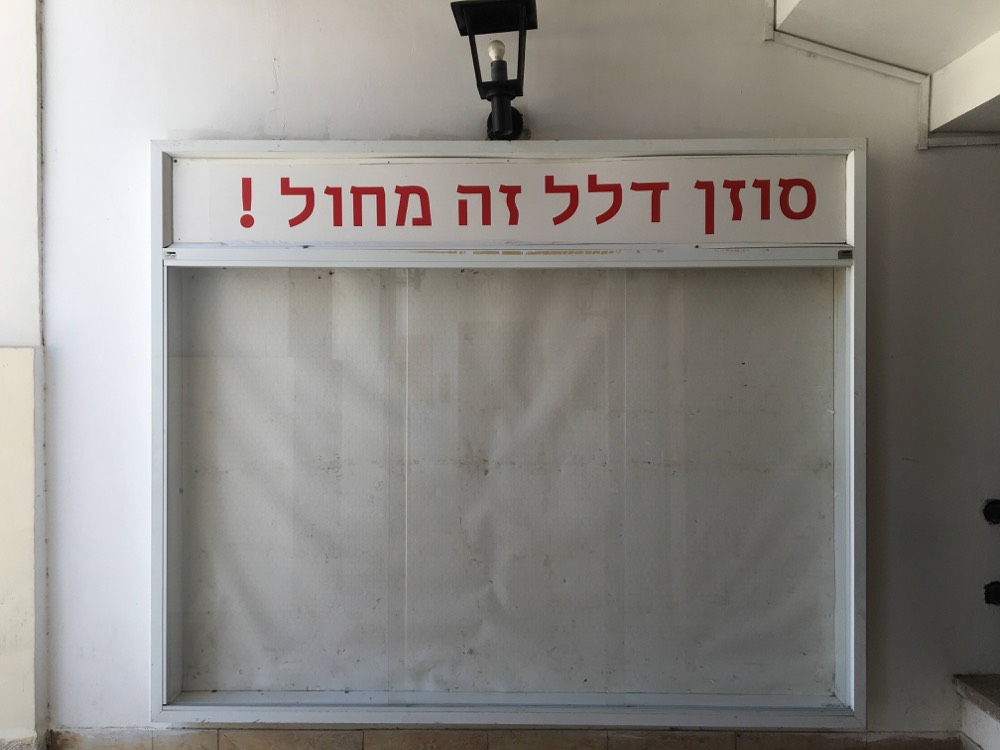Dance at a Distance: Viewing Live Performance in the Context of COVID-19

Going to a performance used to feel as natural as breathing.
Now, it’s a matter of breathing behind a mask.
After more than 3 months of corona times – 3 months during which theaters in Tel Aviv and around the world have been darkened and empty, 3 months during which most rehearsals have been suspended, 3 months during which I normally would have seen shows on a weekly basis – there was finally to be a live performance at the Suzanne Dellal Centre, and I had the opportunity to attend. Since returning to the studio just a few weeks ago, Batsheva Dance Company and Batsheva – The Young Ensemble had been rehearsing Session, the dancers quoting phrases from across Ohad Naharin’s body of work while a DJ mixes tracks in the corner. And on June 25, they would perform for a small group of invited guests.
From the outset, I knew that this experience would be fraught with logistical and emotional complications. I battled some doubts about sitting inside a public place for a prolonged period of time, even if precautions were taken, before accepting the invitation. Reserving my place online, I successfully selected a seat only after an error message popped up repeatedly to say that my previous choices did not abide by the rules of social distancing. The confirmation notice accompanying my e-ticket assured me that the venue was fully compliant with the Ministry of Health’s regulations.
By the time I arrived at the center that evening, attendees were scattered throughout the courtyard, maintaining appropriate distance from one another as they caught up, their words and smiles muffled from behind their masks. At the bottom of the stairs, one staffer clad in gloves and mask took my temperature before another scanned the ticket on my phone. A dispenser of hand sanitizer was mounted at the door to the building, and the studio’s soaring windows were open, allowing for whatever airflow the sticky June evening would permit.
Inside, I found my seat, and indeed, in line with the local standards, there was no one sitting next to me on either side. From across the empty seats, and from behind our masks, another audience member and I chatted about the strangeness of this new world, occasionally glancing around to register the bizarre sight around us. The dancers were not yet visible, but we theater-goers – carefully arrayed across 3 rows on our side of the studio and 3 more rows on the far side – were costumed with facial fabric and choreographed in medically-mandated spatial patterns. Had I witnessed this scene six months ago, it might have been part of an experimental performance set-up. Now it is our new normal.
We audience members had already been transformed by the coronavirus regulations, but how would the situation impact the dancers’ behavior and the work, if at all? Many educational and professional frameworks seem to be focusing on solos, outdoors site-specific work, or video dances, but I was about to watch a live performance in the studio with over 30 dancers, with material created years if not decades earlier. While the movement might not have been designed with COVID-19 in mind, placed in the current context, the motion of these bodies through a shared space would no doubt affect my viewing of Session. Close proximity and physical touch are fundamental both to dance and to our existence as social beings, yet we have been restricted from engaging in such activity even with those we hold dearest. I don’t know when I will next see my parents, who live a 12-hour flight away; I don’t know when my daughter will be allowed to hug or even visit her other grandparents, since the 15-minute drive separating them is complicated by an 80-year age gap. I haven’t seen many of my local friends since February, and even when I do greet them for the first time after months, it is without an embrace. So to see so many dancers together – their sensitive bodies measuring the distance between each other yet showing no special acknowledgment of 2 meters or 6 feet, their skin and flesh sometimes brushing and pressing against another person’s envelope – would inherently feel charged, significant.
As the performance started, it seemed oddly foreign yet comfortingly familiar. The dancers lined the studio and stood shoulder-to-shoulder, unmasked, wholly unprotected. There was something unnerving and thrilling about this closeness and this baring of the body (not even the body, the lower face!), something once so elemental that now read as either a lack of caution or a triumphant signaling of human perseverance. The main company dancers entered the space one by one, their solos carving individual paths without contact – and I found myself thinking about the early days of corona, each pedestrian cautiously avoiding the others on sidewalks and in stores. More and more dancers streamed towards the center, and solos morphed into duets and trios. One dancer advanced as another retreated, the negative space between them palpable to a viewer so attuned to maintaining distance. Three women undulated, waves traveling down their spines, as they rotated around themselves; they were close, and yet their synchronized body rolls kept each safe in her own cocoon. Soon, though, the bubbles of personal space were pierced by the normalcy of physical touch. There were clasps of hands and dancers hauled over others’ torsos; some paired off to quote the fleet-footed partnering from Venezuela, and one perched regally atop another’s shoulders. The clump of dancers usually mid-platform in The Hole assembled in the far corner next to a masked, observant Ohad Naharin and artistic director Gili Navot. The dancers leaned in, sniffed attentively, sensed with every cell, and then, eliminating any last millimeters between them, started juicily pushing into each other. There were no corona pods here, no pacts to minimize transmission. Dancers flitted from one partner, one grouping, to another, and partway through the evening, the cast members’ shared smiles turned into encouraging pats as their compatriots sidled back into the sidelines. The act of touching was contagious.

Meanwhile, I was intoxicated by another act that had been off-limits for the last few months: the act of experiencing a live performance. Throughout the lockdown, I tuned in eagerly to the variety of works now offered online by presenters, companies, and choreographers. Watching dance on screen was, at first, a gift. I could see works which have never come to Tel Aviv and revisited some favorites that were available online. But over and over, I felt let down by the experience. Admittedly, I could not create ideal conditions for my viewing. I watched sitting in my desk chair, slouched on the sofa, or sprawled on my bed, looking at large-scale dances on small tablet and mobile phone screens. I watched during the day with my toddler, who periodically chimed in to say she wanted to see more or fewer dancers onstage, and I watched blurry-eyed late at night after a full day juggling childcare and work, headphones piping the sound into my ears so as not to disturb either my sleeping daughter or my still-toiling husband. I often admired the concept, the craft, and the execution. Sometimes I appreciated the intellectual basis for the work and the historical, aesthetic significance of the dance. But I was not transported from the confines of my home. Separated from the dancers by a screen, and by the years since the dance was filmed, I did not experience any transcendence. I did not feel.
In the studio, though, I felt. There were emotions, some no doubt connected to this unusual context but others spurred by the work itself. And there were feelings springing from and blended with sensations. Presented with a dizzying array of layered choreographic material danced by a large, phenomenal cast, I felt giddily overwhelmed by the choice of what to focus on, my gaze no longer determined by a videographer or editor’s decision. My ears were attuned to differences in volume, perking up with curiosity to catch the softer strains of melodies and filling as the music swelled. When the dancers skipped with loose strides across the length of the space, I could feel the thuds of their footfalls vibrating up through my chair and into my body; when they whooshed by, I enjoyed a slight breeze. As the action grew, as the music built, I readily gave in to a rhythmic swaying, pulsing along with the dancers and other audience members. Then, once the performance ended, I delighted in the act and the sensation of applauding. I have heard the recorded applause at the end of streamed shows, but never was I moved to join in. The repeated rhythmic motion of bringing my hands towards each other, the striking impact reverberating upon contact, the sound I make melding with the sound people around me make – and the knowledge that the dancers can hear our appreciation as we spectators perform this physical act – this has been notably absent from my dance viewing experience during lockdown.
To be in the moment together with these generous performers, to share the space even if the fourth wall remained intact, to breathe the same air even if it was filtered through multiple layers of cotton . . . To measure my own distance from the moving bodies, to register my own stillness and my shifts of weight in my seat, to witness others witnessing . . . On this evening, the full-bodied, multisensory experience and active spectatorship offered by live performance was a revelation – as was the fact that I have taken this for granted, as if live performance was an indestructible condition of our discipline.
Grateful as I am that some artists are sharing their work online – and cognizant as I am that for safety’s sake, online may be the primary if not the only channel for our field under certain circumstances – I emerged from Session more convinced of the necessity of live-ness. For all the innovative approaches to dance-making and presenting that are mediated by technology and may enrich our field moving forward, we also need to preserve the most low-tech, time-honored tradition of bringing performers and audiences together for an in-person experience. Live performance is vital. It is essential, perhaps not to our medical survival of this pandemic, but to our survival as humans. Coming back to the theater will take time and patience, careful adherence to guidelines, and no small dose of vulnerability and courage on the part of artists and audiences alike. A real return to the packed houses and busy performance schedules of yesteryear may take longer than we would like to admit. But return we must, and return we will. It is worth it.
